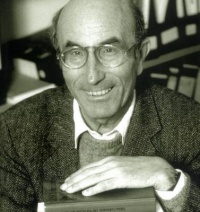Niklas Luhmann
From Geography
Contents |
Life

Famous are the systems theory and their complexity [3]. The systems theory tries to clarify principles that can be applied to all types of systems in all fields of research.
Works
Niklas Luhmann is the author of a great number of (important) scientific publications. Luhmann work is very diverse and he draws upon a wide range of teoretical traditions ands schools of thought (Arnoldi, 2001). But in the Anglo Saxon world Luhmann is only associated with structural functionalism. As a result most of his works ,that is well known, implies the system theory or the autopoietic theory (autopoiesis vs. allopoiesis). All of his work about the systems theory is based on three core theories. First, systems theory as societal theory, second communication theory and last evolution theory. The core element of Luhmann's theory is communication. Social systems are systems of communication, and society is the most encompassing social system. Communication gives meaning to a system. The different modes of meaning processing in systems, constitutes the boundaries between function systems. Without communication there would be no system, so the system theory of Luhman, like Arnoldi says in his article, 'is the rise of order out of chaos (2001).' Being the social system that comprises all (and only) communication, today's society is a world society. A system is defined by a boundary between itself and its environment. Luhmann turned away from action and towards communication and this is how he differed from Talcott Parsons. Luhmann saw social systems not as systems of action but as systems of communication. He saw social systems as an organic system capable of self regulation, and it was namely this self regulation area of his theory that led him to develop autopoiesis in the sociology term. Another term that Luhman uses in his work is the blind spot. If someone observes a system while being a part of it, this part cannot be seen. So the distinction of an observation is the blind spot. In total, Luhmann wrote moren than 70 books and nearly 400 scholarly articles.
References
- Arnoldi, J. (2002). Niklas Luhman. An Introduction. In: Theory, Culture & Society, 18, 1355-1372.
- Gren, M. & Zierhofer, W. (2003). The unity of difference: a critical appraisal of Niklas Luhmann’s theory of social systems in the context of corporeality and spatiality. In: Environment and Planning A., 35, 615-630.
Contributors
- Page created by Bernard Jansen & Sonny Joziasse
- Edited, links and references added by --SamanthaHazlett 20:29, 17 October 2011 (CEST)
- Image inserted and minor enhancements made by --JikkeVanTHof 15:55, 18 October 2011 (CEST)
- Links added by Aafke Brus --AafkeBrus 17:01, 31 October 2011 (CET)
- Page edited by --HennyLi 18:27, 21 October 2012 (CEST)